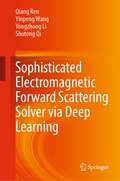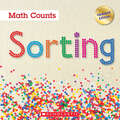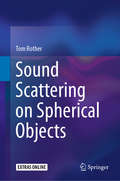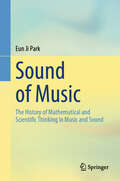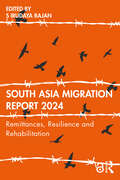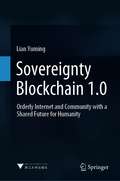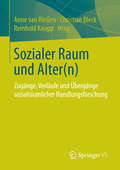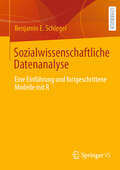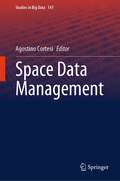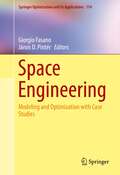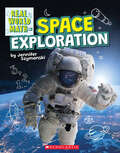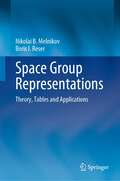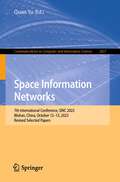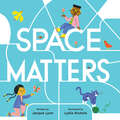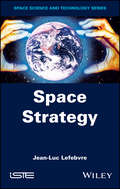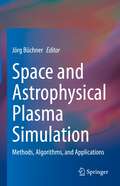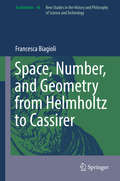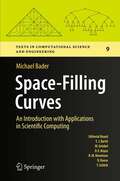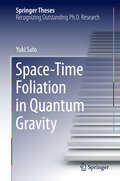- Table View
- List View
Sophisticated Electromagnetic Forward Scattering Solver via Deep Learning
by Qiang Ren Yinpeng Wang Yongzhong Li Shutong QiThis book investigates in detail the deep learning (DL) techniques in electromagnetic (EM) near-field scattering problems, assessing its potential to replace traditional numerical solvers in real-time forecast scenarios. Studies on EM scattering problems have attracted researchers in various fields, such as antenna design, geophysical exploration and remote sensing. Pursuing a holistic perspective, the book introduces the whole workflow in utilizing the DL framework to solve the scattering problems. To achieve precise approximation, medium-scale data sets are sufficient in training the proposed model. As a result, the fully trained framework can realize three orders of magnitude faster than the conventional FDFD solver. It is worth noting that the 2D and 3D scatterers in the scheme can be either lossless medium or metal, allowing the model to be more applicable. This book is intended for graduate students who are interested in deep learning with computational electromagnetics, professional practitioners working on EM scattering, or other corresponding researchers.
Sorting (Math Counts: Updated Editions)
by Henry PluckroseAn introduction to capacity for the youngest readers!Math Counts series introduces young readers (grades K-3) to early math concepts. Real-world examples and corresponding photos make math concepts easy to grasp.When things are sorted together, they are called a set. Things that make up a set have something in common.
Sound Analysis and Synthesis with R (Use R!)
by Jérôme SueurSound is almost always around us, anywhere, at any time, reaching our ears and stimulating our brains for better or worse. Sound can be the disturbing noise of a drill, a merry little tune sung by a friend, the song of a bird in the morning or a clap of thunder at night. The science of sound, or acoustics, studies all types of sounds and therefore covers a wide range of scientific disciplines, from pure to applied acoustics. Research dealing with acoustics requires a sound to be recorded, analyzed, manipulated and, possibly, changed. This is particularly, but not exclusively, the case in bioacoustics and ecoacoustics, two life sciences disciplines that attempt to understand and to eavesdrop on the sound produced by animals. Sound analysis and synthesis can be challenging for students, researchers and practitioners who have few skills in mathematics or physics. However, deciphering the structure of a sound can be useful in behavioral and ecological research – and also very amusing. This book is dedicated to anyone who wants to practice acoustics but does not know much about sound. Acoustic analysis and synthesis are possible, with little effort, using the free and open-source software R with a few specific packages. Combining a bit of theory, a lot of step-by-step examples and a few cases studies, this book shows beginners and experts alike how to record, read, play, decompose, visualize, parametrize, change, and synthesize sound with R, opening a new way of working in bioacoustics and ecoacoustics but also in other acoustic disciplines.
Sound Scattering on Spherical Objects
by Tom RotherThis book introduces readers to scattering from a practical/numerical point of view. The focus is on basic aspects like single scattering, multiple scattering, and whether inhomogeneous boundary conditions or inhomogeneous scatterers have to be taken into account. The powerful T-matrix approach is explained in detail and used throughout the book, and iterative solution methods are discussed. In addition, the book addresses appropriate criteria for estimating the accuracy of numerical results, as well as their importance for practical applications. Python code is provided with each chapter, and can be freely used and modified by readers. Moreover, numerous scattering results for different configurations are provided for benchmarking purposes. The book will be particularly valuable for those readers who plan to develop their own scattering code, and wish to test the correct numerical implementation of the underlying mathematics.
Sound of Music: The History of Mathematical and Scientific Thinking in Music and Sound
by Eun Ji ParkThis book explains that the essence of music lies in intangible mental realms. While vibrations generate sound, and sound forms music, music represents something far beyond mere phenomena—a higher form of expression. This book describes how vibrations are transmitted to the human ear, stirring emotions and ultimately moving the soul. This complex process defies full comprehension. Nevertheless, humanity has long sought to uncover the secrets of music and sound, striving since ancient times to objectively interpret them. This book begins by exploring this endeavor as both a way of observing phenomena and attempting to understand the world, posing the following questions: How have we interpreted music and sound throughout history? What origins have we ascribed to music and sound? How have we analyzed sound phenomena with different technologies up to the present day? Throughout history, scholars have observed and analyzed music and sound from different perspectives, initially seeking to understand sound through numerical frameworks and later employing scientific experimentation to analyze it more precisely. The observations and theories discovered along the way have established a rich body of knowledge, enabling us to accurately understand sound phenomena through mathematics and science. This book emphasizes that the artistic domain of music and the scientifically analyzed realm of sound are bound in an inseparable, symbiotic relationship. It argues that those who truly wish to understand music must acquire knowledge of sound. The quality of sound (La qualité du Son), as this book demonstrates, plays a crucial role in shaping the emotional impact of music, with listeners&’ experiences varying significantly based on sound quality. In some respects, sound itself may play an even more important role than any other aspect in forming music. Ultimately, this book provides foundational knowledge of music and sound from diverse perspectives while explaining their connections within the historical contexts of music and science.
Sources in The Development of Mathematics
by Ranjan RoyThe discovery of infinite products by Wallis and infinite series by Newton marked the beginning of the modern mathematical era. It allowed Newton to solve the problem of finding areas under curves defined by algebraic equations, an achievement beyond the scope of the earlier methods of Torricelli, Fermat and Pascal. While Newton and his contemporaries, including Leibniz and the Bernoullis, concentrated on mathematical analysis and physics, Euler's prodigious accomplishments demonstrated that series and products could also address problems in algebra, combinatorics and number theory. In this book, Ranjan Roy describes many facets of the discovery and use of infinite series and products as worked out by their originators, including mathematicians from Asia, Europe and America. The text provides context and motivation for these discoveries, with many detailed proofs, offering a valuable perspective on modern mathematics. Mathematicians, mathematics students, physicists and engineers will all read this book with benefit and enjoyment.
South Asia Migration Report 2024: Remittances, Resilience and Rehabilitation
by S Irudaya RajanSouth Asia Migration Report 2024 documents key themes of remittances, resilience, and rehabilitation from the region.This volume: • Includes dedicated fieldwork to map migration within and outside South Asia;• Analyses the impact of Covid-19 on migrants and migration in South Asia;• Highlights the plight of Afghan migrants post-Taliban takeover in the country. This book will be indispensable for scholars and researchers of economics, development studies, migration and diaspora studies, gender studies, labour studies and sociology. It will also be useful to policymakers, think tanks and government institutions working in the area.
South Asians in Southern Europe: Exploring Labour, Identity, and Desire (Migration, Diasporas and Citizenship)
by Reena KukrejaThis book focuses on an emerging group of low income South Asian migrants who are increasingly migrating to four Southern European countries: Greece, Italy, Spain, and Portugal. While homogenized under the overarching category of &“South Asian,&” the migrant trajectories and migrant experiences and encounters in these host countries are quite disparate and distinct from each other. The empirically rich contributions in the volume examine how national, religious, ethnic, gender, and/or class differences shape differing outcomes in migration trajectories, livelihood strategies, inclusion in host communities, family reunification, and migrant subjectivity for this set of racialized migrants and their families. The volume focusses on four broad themes, namely: Migration governance and labour regimes; Migration strategies and experience – transnational mobility and social mobility; Identity and belonging; and Family and gender relations. This book fills a gap in scholarly works in the fields of migration studies, diaspora studies, and migrant labour, and it will be of interest to students and scholars in these and related fields.
South Carolina Performance Coach, Mathematics, [Grade] 6
by Triumph Learning LlcNIMAC-sourced textbook
Southern Anthropocenes (CRESC)
by Casper Bruun JensenThis wide‑ranging volume addresses the changing landscape of problems, challenges, and possibilities that emerge once the macroscopic notion of the Anthropocene is replaced with Southern Anthropocenes. It envisions Southern Anthropocenes as an opening towards forms and ends of life that exceed—while remaining in partial relation with—modern socio‑economic horizons and the determinations of the geo‑, eco‑, and climate sciences.What happens if Southern Anthropocenes are allowed to multiply, and room is made for practices of worlding and life that are impossible from within the singular Anthropocene?Key issues include emergent interfaces between beings, ways of living, and worlds; problems of co‑existence in and across pluriversal contact zones; explorations of liveability under rapidly changing circumstances; speculations about other futures and how to invent them; investigations of more‑than‑human itineraries and entangled territories; and explorations of how to collectively invent the portals between ways of thinking and acting on a planet in a critical state. It will be essential reading for advanced undergraduate and postgraduate students in Sociology, Anthropology, Critical Education, Environmental Humanities, Science and Technology Studies, Geography, and Urban Studies.
Sovereignty Blockchain 1.0: Orderly Internet and Community with a Shared Future for Humanity
by Lian YumingThis book presents a general framework analysis of sovereignty in blockchain based on the concept of blockchain technology, and specifically discusses the three theoretical foundations of sovereignty in blockchain: data sovereignty theory, social trust theory, and smart contract theory. It also explores the evolution of laws concerning data and digital rights, how to build trust mechanisms for digital rights transactions, as well as contract signing and the implementation of digital rights transactions.
Soziale Herkunft und mathematisches Modellieren: Modellierungsprozesse sozial benachteiligter und begünstigter Schüler:innen (Studien zur theoretischen und empirischen Forschung in der Mathematikdidaktik)
by Ilja AySoziale Ungleichheit im Bildungswesen stellt eine wesentliche Herausforderung moderner Gesellschaften dar. Zusammenhänge zwischen der sozialen Herkunft von Schüler:innen und ihrer Mathematikleistung können statistisch vielfach nachgewiesen werden. Ebenso legen zahlreiche Studien nahe, dass das System Schule dazu tendiert, die außerschulischen Handlungslogiken sozial benachteiligter Personen als defizitärer einzustufen. Gerade beim Umgang mit Modellierungsaufgaben, d.h. realitätsnahen und offenen Problemen, können die außerschulischen Logiken von Schüler:innen wirksam werden. Die Bedeutung mathematischen Modellierens für soziale Ungleichheit wird dabei in der Literatur kontrovers diskutiert. Diese qualitativ angelegte Forschungsstudie untersucht auf Grundlage von Bourdieus Konzepten Mechanismen sozialer Ungleichheit beim Modellieren aus einer bildungssoziologischen Perspektive, die die Verfügbarkeit von Ressourcen und die häusliche Sozialisation von Schüler:innen in den Blick nimmt. Diskutiert werden Auffälligkeiten, die sich beim Bearbeiten von Modellierungsaufgaben bei Schüler:innen unterschiedlicher sozialer Herkunft zeigen. Damit soll insgesamt ein Beitrag dazu geleistet werden, Herausforderungen und Potentiale mathematischen Modellierens für einen sozial gerechteren Unterricht zu diskutieren.
Sozialer Raum und Alter(n)
by Anne Van Rießen Christian Bleck Reinhold KnoppDie zunehmende Alterung der Gesellschaft hat in den vergangenen Jahren dazu geführt, dass sozialräumliche Voraussetzungen und Perspektiven älterer Menschen stärker in den Fokus sozialpolitischer, städtebaulicher und wissenschaftlicher Diskurse gerückt sind. In diesem Sammelband werden die Schwerpunktthemen Sozialer Raum und Alter(n) anhand ausgewählter theoretischer Grundlagen und aktueller Forschungsprojekte - unter den Kategorien Zugänge, Verläufe und Übergänge - dargestellt und kritisch diskutiert.
Sozialwissenschaftliche Datenanalyse: Eine Einführung und fortgeschrittene Modelle mit R
by Benjamin E. SchlegelSozialwissenschaftliche Analyseverfahren helfen uns, Daten richtig zu verstehen und fundierte Schlüsse zu ziehen. Dieses Lehrbuch bietet eine schrittweise Einführung in die Grundlagen der Datenanalyse. Es beginnt mit deskriptiven Analysen, führt über lineare Regressionen und behandelt anschließend weiterführende, komplexere statistische Modelle. Mithilfe des frei verfügbaren Statistikprogramms R werden die Analysen anschaulich umgesetzt, um die theoretischen Konzepte greifbarer zu machen. Zusätzlich stellt der Autor Quarto Markdown vor – ein Werkzeug, das das Erstellen von Seminar-, Bachelor- und Masterarbeiten auf technischer Ebene erheblich erleichtert. Übungen am Ende der Kapitel fördern die Anwendung und Vertiefung des Gelernten. Dieses Buch richtet sich primär an Studierende der Sozialwissenschaften.
Space Data Management (Studies in Big Data #141)
by Agostino CortesiThe book presents latest results pertaining to challenges faced by researchers in space data management. There are large number of highly important applications that currently rely upon data from satellites and space missions, ranging from weather prediction to monitoring of environmental pollution, climate change, marine traffic, agriculture, and urban planning, etc. The quality and quantity of space data poses new and specific challenges to the scientific community, covering the entire life cycle of space data management and with a need for an interdisciplinary approach. The chapters written by experts discusses impacts of these challenges, and report activities that can stimulate new research.
Space Engineering: Modeling and Optimization with Case Studies (Springer Optimization and Its Applications #114)
by Giorgio Fasano János D. PintérThis book presents a selection of advanced case studies that cover a substantial range of issues and real-world challenges and applications in space engineering. Vital mathematical modeling, optimization methodologies and numerical solution aspects of each application case study are presented in detail, with discussions of a range of advanced model development and solution techniques and tools.Space engineering challenges are discussed in the following contexts: •Advanced Space Vehicle Design•Computation of Optimal Low Thrust Transfers•Indirect Optimization of Spacecraft Trajectories•Resource-Constrained Scheduling,•Packing Problems in Space•Design of Complex Interplanetary Trajectories•Satellite Constellation Image Acquisition•Re-entry Test Vehicle Configuration Selection•Collision Risk Assessment on Perturbed Orbits•Optimal Robust Design of Hybrid Rocket Engines•Nonlinear Regression Analysis in Space Engineering•Regression-Based Sensitivity Analysis and Robust Design•Low-Thrust Multi-Revolution Orbit Transfers•Modeling and Optimization of Balance Layout Problems•Pilot-Induced Oscillations Alleviation•Modeling and Optimization of Hybrid Transfers to Near-Earth Objects•Probabilistic Safety Analysis of the Collision Between Space Debris and Satellite•Flatness-based Low-thrust Trajectory Optimization for Spacecraft Proximity Operations The contributing authors are expert researchers and practitioners in either the space engineering and/or in the applied optimization fields. Researchers and practitioners working in various applied aspects of space engineering will find this book practical and informative. Academics, graduate and post-graduate students in aerospace engineering, applied mathematics, operations research, optimization, and optimal control, will find this book useful.
Space Exploration (Real World Math)
by Jennifer SzymanskiGrab your space suit and get ready to use math to explore space!3 … 2 … 1 … blast off! Space scientists use math every day to explore our universe. Join a real astronomer on an amazing adventure to COUNT the planets, MEASURE the stars, ADD on the space station, and more. Then test your math skills with special You Can Do It challenges.This brand-new series demonstrates how math skills can be applied to high-interest topics and careers in Coding, Building, Tracking Animals, and Space Exploration. The K-2 math concepts include counting 1-100 with basic addition and subtraction, using the power of 10, measuring, and simple geometry. Real world scientists, architects, programmers, and mathematicians model hands-on, from-the-field experiences in a way that will make children excited to use and expand their math skills!
Space Group Representations: Theory, Tables and Applications
by Nikolai B. Melnikov Boris I. ReserThis book is devoted to the construction of space group representations, their tabulation, and illustration of their use. Representation theory of space groups has a wide range of applications in modern physics and chemistry, including studies of electron and phonon spectra, structural and magnetic phase transitions, spectroscopy, neutron scattering, and superconductivity. The book presents a clear and practical method of deducing the matrices of all irreducible representations, including double-valued, and tabulates the matrices of irreducible projective representations for all 32 crystallographic point groups. One obtains the irreducible representations of all 230 space groups by multiplying the matrices presented in these compact and convenient to use tables by easily computed factors. A number of applications to the electronic band structure calculations are illustrated through real-life examples of different crystal structures. The book's content is accessible to both graduate and advanced undergraduate students with elementary knowledge of group theory and is useful to a wide range of experimentalists and theorists in materials and solid-state physics.
Space Information Networks: 7th International Conference, SINC 2023, Wuhan, China, October 12–13, 2023, Revised Selected Papers (Communications in Computer and Information Science #2057)
by Quan YuThis book constitutes revised selected papers from the thoroughly refereed proceedings of the 7th International Conference on Space Information Network, SINC 2023, held in Wuhan, China, during October 12–13, 2023. The 8 full papers and 5 short papers included in this book were carefully reviewed and selected from 73 submissions. The papers present the latest research in the fields of space information networks.
Space Matters
by Jacque LynnGently encourage mindfulness and critical thinking through this playful and witty exploration of negative space. Can empty space be useful? Can it lead to new perspectives and new appreciation? Might it even be inspiring? Find out in a winsome book that draws on a child&’s everyday experiences to prompt readers to look twice at their surroundings and notice the significance of sights, sounds, and spaces otherwise taken for granted.
Space Strategy
by Jean-Luc Lefebvre"If there has not been a war in space, there is already more war without space!" To understand the spatial strategy, we must first know the environment and delineate the field. It must then assess the strategic importance of space. Finally, we must imagine the possibilities of a fight since, against and in space. Space Strategy responds to this questioning. Moreover, this book explicitly established concepts, such as the militarization and weaponization of space; it innovates by setting the "martialisation of space". It shows how space assets are a key component of information literacy, the key to power in the next century. Finally, it sets out a number of principles and lays the foundation for a future strategy and using the Moon Lagrange points.
Space and Astrophysical Plasma Simulation: Methods, Algorithms, and Applications
by Jörg BüchnerThis book is a collection of contributions covering the major subjects in numerical simulation of space and astrophysical plasma. It introduces the different approaches and methods to model plasma, the necessary computational codes, and applications in the field. The book is rooted in the previous work Space Plasma Simulation (Springer, 2003) and includes the latest developments. It is divided into three parts and all chapters start with an introduction motivating the topic and its use in research and ends with a discussion of its applications. The chapters of the first part contain tutorials of the different basic approaches needed to perform space plasma simulations. This part is particularly useful for graduate students to master the subject. The second part presents more advanced materials for students and researchers who already work with pre-existing codes but want to implement the recent progresses made in the field. The last part of the book discusses developments in the area for researchers who are actively working on advanced simulation approaches like higher order schemes and artificial intelligence, agent-based technologies for multiscale and multi-dimensional systems, which represent the recent innovative contributions made in space plasma research.
Space, Number, and Geometry from Helmholtz to Cassirer
by Francesca BiagioliThis book offers a reconstruction of the debate on non-Euclidean geometry in neo-Kantianism between the second half of the nineteenth century and the first decades of the twentieth century. Kant famously characterized space and time as a priori forms of intuitions, which lie at the foundation of mathematical knowledge. The success of his philosophical account of space was due not least to the fact that Euclidean geometry was widely considered to be a model of certainty at his time. However, such later scientific developments as non-Euclidean geometries and Einstein's general theory of relativity called into question the certainty of Euclidean geometry and posed the problem of reconsidering space as an open question for empirical research. The transformation of the concept of space from a source of knowledge to an object of research can be traced back to a tradition, which includes such mathematicians as Carl Friedrich Gauss, Bernhard Riemann, Richard Dedekind, Felix Klein, and Henri Poincaré, and which finds one of its clearest expressions in Hermann von Helmholtz's epistemological works. Although Helmholtz formulated compelling objections to Kant, the author reconsiders different strategies for a philosophical account of the same transformation from a neo-Kantian perspective, and especially Hermann Cohen's account of the aprioricity of mathematics in terms of applicability and Ernst Cassirer's reformulation of the a priori of space in terms of a system of hypotheses. This book is ideal for students, scholars and researchers who wish to broaden their knowledge of non-Euclidean geometry or neo-Kantianism.
Space-Filling Curves
by Michael BaderThe present book provides an introduction to using space-filling curves (SFC) as tools in scientific computing. Special focus is laid on the representation of SFC and on resulting algorithms. For example, grammar-based techniques are introduced for traversals of Cartesian and octree-type meshes, and arithmetisation of SFC is explained to compute SFC mappings and indexings. The locality properties of SFC are discussed in detail, together with their importance for algorithms. Templates for parallelisation and cache-efficient algorithms are presented to reflect the most important applications of SFC in scientific computing. Special attention is also given to the interplay of adaptive mesh refinement and SFC, including the structured refinement of triangular and tetrahedral grids. For each topic, a short overview is given on the most important publications and recent research activities.
Space-Time Foliation in Quantum Gravity
by Yuki SatoIn this thesis, the author considers quantum gravity to investigate the mysterious origin of our universe and its mechanisms. He and his collaborators have greatly improved the analyticity of two models: causal dynamical triangulations (CDT) and n-DBI gravity, with the space-time foliation which is one common factor shared by these two separate models. In the first part, the analytic method of coupling matters to CDT in 2-dimensional toy models is proposed to uncover the underlying mechanisms of the universe and to remove ambiguities remaining in CDT. As a result, the wave function of the 2-dimensional universe where matters are coupled is derived. The behavior of the wave function reveals that the Hausdorff dimension can be changed when the matter is non-unitary. In the second part, the n-DBI gravity model is considered. The author mainly investigates two effects driven by the space-time foliation: the appearance of a new conserved charge in black holes and an extra scalar mode of the graviton. The former implies a breakdown of the black-hole uniqueness theorem while the latter does not show any pathological behavior.
